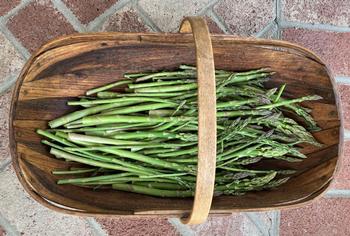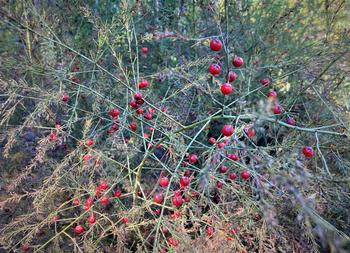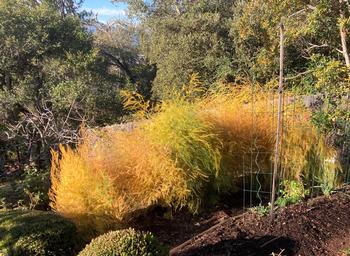Spring starts with “A” for Asparagus
-
Alice Cason
-
Growing asparagus requires patience. From planting to the first harvest takes two to three years, but the wait is well worth the rewards. Known as asparagus officinalis, asparagus is native to the sea coasts of Europe, North Africa, and Asia. I love to think of it as it was served at banquets in ancient Rome and Greece. Early settlers brought the seeds to America. Asparagus is one of the most permanent, dependable garden vegetables. A dedicated bed will produce a bountiful supply for 12 -15 years.
 During harvest, check your asparagus bed every day. Pick the spears when they are tight and smooth. Photo: Alice Cason
During harvest, check your asparagus bed every day. Pick the spears when they are tight and smooth. Photo: Alice CasonChoose a site with good drainage in full sun. The tall fern-like foliage will reach a height of 5- 6 feet during the summer, so place the bed parallel to the prevailing wind, where it will not shade out smaller plants and prevent bent tips. Good soil preparation is essential. Amend the soil with plenty of organic matter, aged manure, or compost. Remove any weeds and old roots.
January through March is the time to plant dormant first-year crowns that look like an octopus with long fleshy roots. Dig a trench that allows drainage, 8 – 10 inches deep. Place the crown at the bottom of the trench, fanning out the roots 12 inches apart. Mound the soil under each plant, so the crown is above the roots. Cover with soil until it reaches ground level.
Asparagus plants are male and female. Watch for the female plant with red berries. Do not eat the berries, as they are poisonous. You can also start plants from the seeds, but this will add another year’s time to the harvesting schedule. Do not eat the female asparagus berries that form on the feathery branches, as they are poisonous. Photo: Alice Cason
Do not eat the female asparagus berries that form on the feathery branches, as they are poisonous. Photo: Alice CasonWater as needed with drip irrigation (not overhead). Marin Master gardeners recommend asparagus for a water-conserving vegetable garden. Spears usually get plenty of rainwater during the harvesting season. For more information on drought-tolerant vegetables, see https://marinmg.ucanr.edu/EDIBLES/CONSERVING/.
Do not harvest the first year. Asparagus takes several years to mature and develop strong roots. Wait to harvest until the second year for one-year-old crowns and two years for seeds. Then harvest lightly for 2- 3 weeks, leaving the rest to develop foliage. A well-established garden will produce better in the long term. Increase the harvest each year, cutting the spears at the soil surface. At maturity, you should be able to harvest every day or every other day. Refrigerate the spears as they accumulate to be cooked. I harvest starting in March, with full harvest picking every day in April and May. When you are ready to stop harvesting, allow the foliage to form a hedge that will grow up to 6 feet tall.
Recommended disease-resistant varieties include Mary Washington, UC72, and UC157. Mary Washington is the most popular green asparagus. It produces thick, uniform spears and a heavy yield and is disease-resistant to rust. UC72 is also known as "Mary's Granddaughter." Developed at UC Davis, this variety is heat and drought-tolerant. It yields heavy dark green spears with compact heads. UC157 (Non-GMO) is a hybrid asparagus. This variety was developed at the University of California at Riverside in 1978 and has become the most widely sown asparagus.
In the late fall, the asparagus foliage turns a beautiful golden color. That is the time to cut the foliage to the ground and clean up the debris. That will help get rid of any overwintering asparagus beetles and other pests. Mulch with compost or manure. I like to apply compost and cover the beds with straw for the winter to help control weeds while adding organic matter and nutrients. In the fall, the asparagus foliage turns golden and it's time to cut it to the ground and feed the soil for next year's harvest. Photo: Alice Cason
In the fall, the asparagus foliage turns golden and it's time to cut it to the ground and feed the soil for next year's harvest. Photo: Alice CasonPlant asparagus once and reap the rewards for many years. Asparagus can be steamed, boiled, sauteed, grilled, stir-fried, pureed for soup, and baked in a tart. Marin Master Gardeners have “grow and care” sheets to help your garden grow: https://marinmg.ucanr.edu/EDIBLES/EDIBLES_GROW_SHEETS/?uid=6&ds=996.



